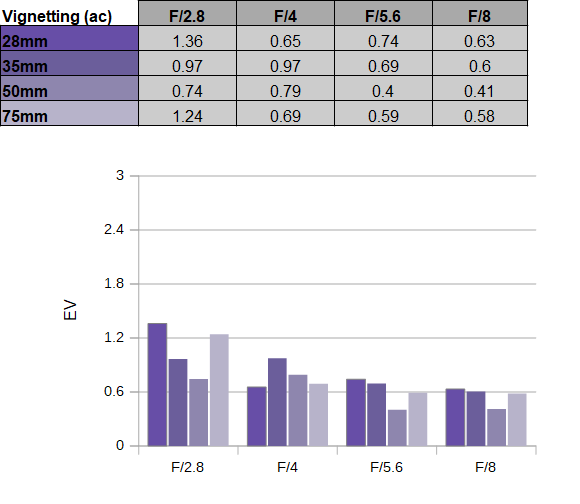|
Tamron 28-75mm f/2.8 Di III VXD G2 - Review / Test Report - Analysis |
|
Lens Reviews -
Sony Alpha (Full Format)
|
|
Page 2 of 3

Distortion
Image auto-correction is the de-facto standard today. Activated, you don't have to worry about distortions as you can see below.
When looking at the RAW characteristic, things aren't all that rosy anymore. A barrel distortion of ~2.3% at 28mm is actually pretty commendable. The high pincushion distortion in the middle and upper part of the zoom range is much worse than usual - also compared to its predecessor.
Vignetting
In standard shooting mode (auto-correction activated), the vignetting is well-controlled. There are rather "normal" peaks of around 1.5EV (f-stops) at the extreme ends of the zoom range at f/2.8. However, the light falloff is quite moderate at other settings.
 As you may have guessed, the situation is much worse again in the original RAW files. The light falloff reaches ~3EV (f-stops) at 28mm f/2.8 and also 70mm f/2.8. You have to stop down to at least f/5.6 for more sane results. Thus auto-correction is boosting the image signal in the corners by 1.5 f-stops with the corresponding impact on sensor noise.
As you may have guessed, the situation is much worse again in the original RAW files. The light falloff reaches ~3EV (f-stops) at 28mm f/2.8 and also 70mm f/2.8. You have to stop down to at least f/5.6 for more sane results. Thus auto-correction is boosting the image signal in the corners by 1.5 f-stops with the corresponding impact on sensor noise.

MTF (resolution at 42 megapixel)
While we haven't seen anything overly impressive so far, the Tamron 28-75mm f/2.8 Di III VXD G2 can deliver impressive image sharpness across most of its range. In terms of balance, Tamron prioritized the wide end of the zoom range - which makes sense. The image quality is great at this setting, with outstanding center sharpness and very good borders/corners. The center performance is maintained at 35mm and 50mm, whereas the quality of the outer image field is slightly reduced. A more noticeable drop in quality is present at 75mm. The center quality is still pretty high, but a very slight softness creeps in at the borders/corners. Given the fact that most users will primarily shoot at f/2.8, this is still a good compromise when looking at the overall characteristic.
The field curvature is low. The centering quality of the tested sample was Ok.
Please note that the MTF results are not directly comparable across the different systems!
Below is a simplified summary of the formal findings. The chart shows line widths per picture height (LW/PH) which can be taken as a measure of sharpness.
If you want to know more about the MTF50 figures, you may check out the corresponding Imatest Explanations

Chromatic Aberrations (CAs)
Once again - on Sony cameras, you don't really have to worry about chromatic aberrations due to image auto-correction. However, the RAW CAs are comparatively high, peaking beyond 2px on average at the image corners.

Bokeh
If you are in the market for a fast standard zoom lens, you are probably also interested in the quality of the bokeh. And this is a strength of the Tamron 28-75mm f/2.8 Di III VXD G2. Standard zoom lenses don't deliver smooth out-of-focus highlights like prime lenses, but the Tamron lens comes surprisingly close. The highlight discs are very smooth, with just a hint of nervousness and no obvious outlining.
 When looking at the complete image frame, the circular shape of the highlight discs is maintained over a fairly broad field. However, they do deteriorate in the image corners due to mechanical vignetting, as you can see below. Stopping down to f/5.6 recovers most of the circular shape.
The quality of the general blur is very smooth both in the image background and foreground. That's a rare quality not only among zoom lenses.
When looking at the complete image frame, the circular shape of the highlight discs is maintained over a fairly broad field. However, they do deteriorate in the image corners due to mechanical vignetting, as you can see below. Stopping down to f/5.6 recovers most of the circular shape.
The quality of the general blur is very smooth both in the image background and foreground. That's a rare quality not only among zoom lenses.

Bokeh Fringing / LoCA
Boheh fringing (also called LoCA) is an axial color fringing effect with purplish halos in front of the focus point and greenish beyond.
The Tamron lens exhibits only moderate fringing at f/2.8, and it's almost gone at f/4. Once again, a good result.
Sun Stars
Below is s sequence of images from f/2.8 all the way up to f/16 - illustrating the Sunstar behavior (using LED lights). Sunstars are an aperture effect when shooting bright light sources such as street lights, the sun, etc. At f/2.8, thus at maximum aperture, the effect is very underdeveloped simply because the aperture is basically circular. The Sunstar effect increases slowly the more you stop down. However, it's only becoming really obvious from f/11 and it's best at f/16. When looking closely, the rendering of the rays is a bit fan-like, with distinctive edges. Not optimal, but not bad either.
Note: We are still in a bit of an experimental phase in this image quality category. We have yet to improve the black background of the test target.
|